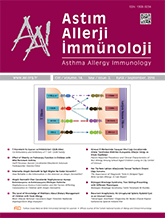


Objective: The aims of the study were to evaluate the prevalence of Staphylococcus aureus (S. aureus) colonization and to determine the risk factors related to colonization.
Materials and Methods: Nasal swab cultures were obtained from all participants. Lesional skin swabs were taken from atopic children and fingertip skin swabs were taken from healthy controls. The severity of atopic dermatitis was evaluated by using the SCORing Atopic Dermatitis (SCORAD) and Eczema Severity and Scoring Index (EASI) scores at the beginning and also at the end of the study after a year of follow-up. Serum total IgE levels were measured. Atopic status was evaluated by skin prick tests.
Results: Nasal S. aureus colonization was higher in children with atopic dermatitis compared to healthy controls (p=0.034). Both nasal and skin S. aureus colonization was associated with disease severity (p=0.047, p=0.04, respectively). Nasal S. aureus colonization was significantly associated with male gender, high serum total IgE levels, extrinsic atopic dermatitis and skin S. aureus colonization (p<0.05). Skin S. aureus colonization was only associated with nasal S. aureus colonization (p=0.012). In logistic regression analysis, female gender [p=0.04, adjusted Odds Ratio (aOR):0.15, 95% Coefficient Interval (CI): 0.28-0.916], and having non-colonized skin with S.aureus (p=0.027, aOR:0.14, 95% CI:0.26-0.807) were associated with lower risk for nasal S. aureus colonization, whereas, high serum total IgE levels were associated with increased risk for nasal S. aureus colonization (p=0.026, aOR:1.04; 95% CI: 1.001-1.008).
Conclusion: Nasal S. aureus colonization is high in children with atopic dermatitis. Both nasal and skin S. aureus colonization are associated with disease severity. Male gender, high serum IgE levels and skin S. aureus colonization are associated with nasal S. aureus colonization.